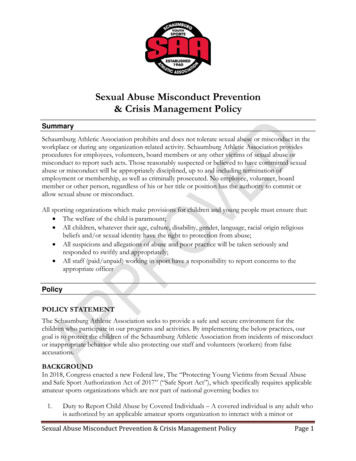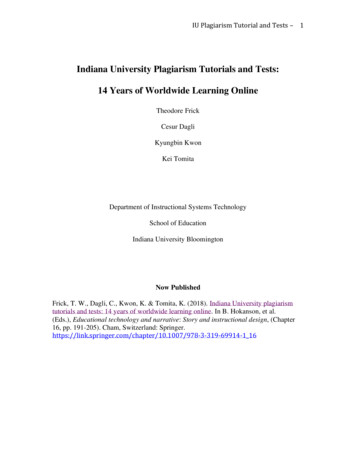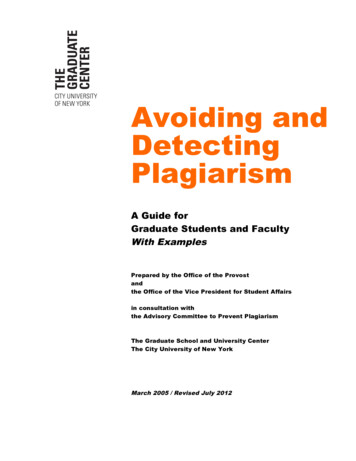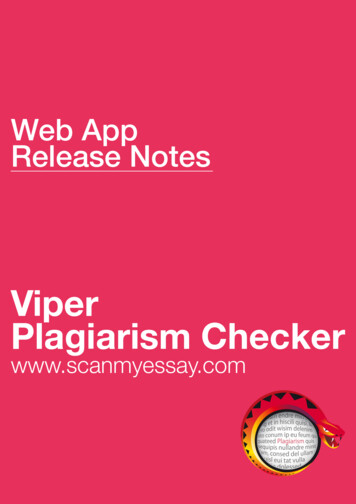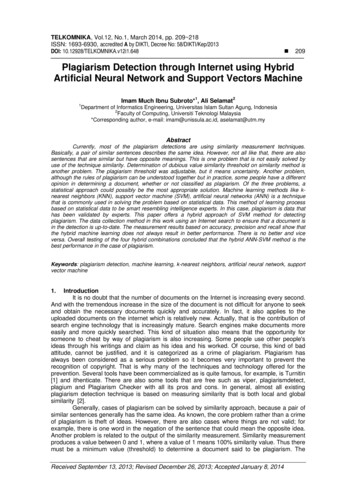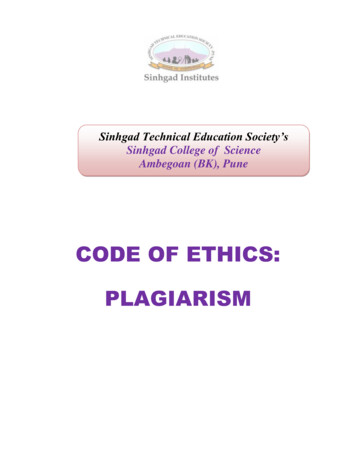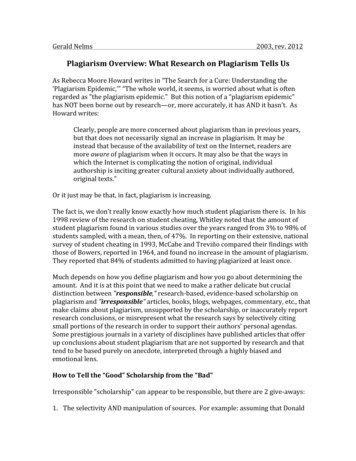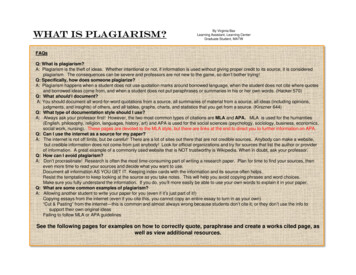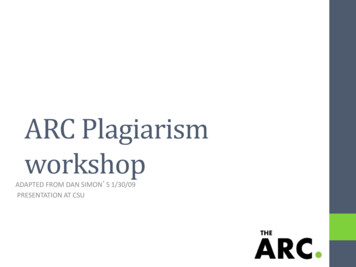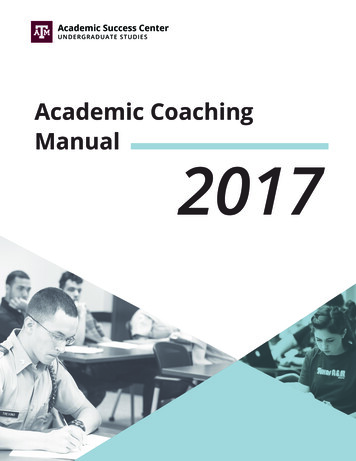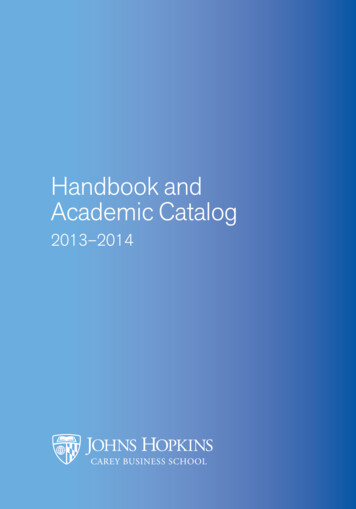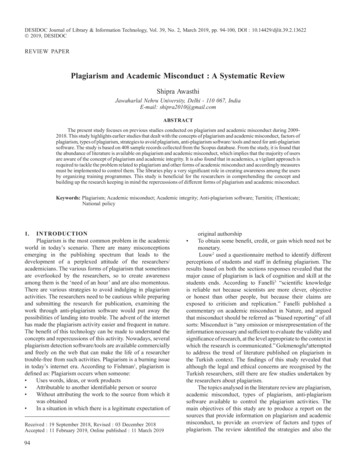
Transcription
DESIDOC Journal of Library & Information Technology, Vol. 39, No. 2, March 2019, pp. 94-100, DOI : 10.14429/djlit.39.2.13622 2019, DESIDOCREVIEW PAPERPlagiarism and Academic Misconduct : A Systematic ReviewShipra AwasthiJawaharlal Nehru University, Delhi - 110 067, IndiaE-mail: shipra2010@gmail.comAbstractThe present study focuses on previous studies conducted on plagiarism and academic misconduct during 20092018. This study highlights earlier studies that dealt with the concepts of plagiarism and academic misconduct, factors ofplagiarism, types of plagiarism, strategies to avoid plagiarism, anti-plagiarism software/ tools and need for anti-plagiarismsoftware. The study is based on 408 sample records collected from the Scopus database. From the study, it is found thatthe abundance of literature is available on plagiarism and academic misconduct, which implies that the majority of usersare aware of the concept of plagiarism and academic integrity. It is also found that in academics, a vigilant approach isrequired to tackle the problem related to plagiarism and other forms of academic misconduct and accordingly measuresmust be implemented to control them. The libraries play a very significant role in creating awareness among the usersby organizing training programmes. This study is beneficial for the researchers in comprehending the concept andbuilding up the research keeping in mind the repercussions of different forms of plagiarism and academic misconduct.Keywords: Plagiarism; Academic misconduct; Academic integrity; Anti-plagiarism software; Turnitin; iThenticate;National policy1.IntroductionPlagiarism is the most common problem in the academicworld in today’s scenario. There are many misconceptionsemerging in the publishing spectrum that leads to thedevelopment of a perplexed attitude of the researchers/academicians. The various forms of plagiarism that sometimesare overlooked by the researchers, so to create awarenessamong them is the ‘need of an hour’ and are also momentous.There are various strategies to avoid indulging in plagiarismactivities. The researchers need to be cautious while preparingand submitting the research for publication, examining thework through anti-plagiarism software would put away thepossibilities of landing into trouble. The advent of the internethas made the plagiarism activity easier and frequent in nature.The benefit of this technology can be made to understand theconcepts and repercussions of this activity. Nowadays, severalplagiarism detection software/tools are available commerciallyand freely on the web that can make the life of a researchertrouble-free from such activities. Plagiarism is a burning issuein today’s internet era. According to Fishman1, plagiarism isdefined as: Plagiarism occurs when someone: Uses words, ideas, or work products Attributable to another identifiable person or source Without attributing the work to the source from which itwas obtained In a situation in which there is a legitimate expectation ofReceived : 19 September 2018, Revised : 03 December 2018Accepted : 11 February 2019, Online published : 11 March 201994original authorshipTo obtain some benefit, credit, or gain which need not bemonetary.Louw2 used a questionnaire method to identify differentperceptions of students and staff in defining plagiarism. Theresults based on both the sections responses revealed that themajor cause of plagiarism is lack of cognition and skill at thestudents ends. According to Fanelli3 “scientific knowledgeis reliable not because scientists are more clever, objectiveor honest than other people, but because their claims areexposed to criticism and replication.” Fanelli published acommentary on academic misconduct in Nature, and arguedthat misconduct should be referred as “biased reporting” of allsorts: Misconduct is “any omission or misrepresentation of theinformation necessary and sufficient to evaluate the validity andsignificance of research, at the level appropriate to the context inwhich the research is communicated.” Gokmenoglu4attemptedto address the trend of literature published on plagiarism inthe Turkish context. The findings of this study revealed thatalthough the legal and ethical concerns are recognised by theTurkish researchers, still there are few studies undertaken bythe researchers about plagiarism.The topics analysed in the literature review are plagiarism,academic misconduct, types of plagiarism, anti-plagiarismsoftware available to control the plagiarism activities. Themain objectives of this study are to produce a report on thesources that provide information on plagiarism and academicmisconduct, to provide an overview of factors and types ofplagiarism. The review identified the strategies and also the
Awasthi : Plagiarism and Academic Misconduct : A Systematic Reviewrole of the libraries to deal with these activities. This researchis expected to assist other researchers in enhancing theirknowledge in the field of plagiarism and academic misconduct2.MethodologyThe present study was designed as a systematic reviewstudy that aims to analyse the content and findings of previousstudies conducted on plagiarism and academic misconductduring 2009- 2018. Cochrane5 expressed that “A systematicliterature review attempts “to identify, appraise and synthesiseall the empirical evidence that meets pre-specified eligibilitycriteria to answer a given research question. Researchersconducting systematic reviews use explicit methods aimed atminimising bias, to produce more reliable findings that canbe used to inform decision making.” The sample of the studyis collected from the bibliographic database Scopus. Total2518 record were found by using the keywords ‘academicmisconduct’ and ‘Plagiarism.’Due to the availability of vast literature, the criterionwas formulated to determine the relevance of the 2518record. The inclusion of literature for analysis was basedon the criteria that the publication which deals with factorsand reasons for plagiarism, types of plagiarism, strategiesto avoid plagiarism, anti-plagiarism software tool andacademic misconduct was included in the study. The sampleof 42 article on academic misconduct and 366 on Plagiarism,i.e., 408 article are considered relevant for the study.3.Factors of PlagiarismThe research on Plagiarism has identified several factorsthat contribute to Plagiarism and academic misconduct.Hongwei6, et. al. used structural equation modeling (SEM) totest a conceptual model of five factor using data from a sampleof 2,503 college students. The results indicated that there is asignificant direct association between students’ reported lackof self-control and research misconduct. Bahadori7, et. al.reviewed the scientific concepts connected with plagiarism,its factors, and to create awareness among the instructorsand students the methods of detecting plagiarism need to beimproved. Factors that have been identified as contributors toplagiarism are many. Salleh8 suggested that the organisation,facility of internet and individuals attitude are the chief factorsthat contribute to plagiarism. Jereb9, et. al. conducted the studyat the University of Maribor in Slovenia. The results revealedthat there are gender differences in the awareness of plagiarismamong students; and highlighted that women have a much morenegative approach towards plagiarism as compared to men.Starovoytova10 studied a-cross-sectional-survey, conductedat the school of engineering. The findings revealed that themajority (60 %) of the-respondents mentioned that they werenot made aware of the concept of plagiarism. Harji11, et. al.reported in a study that observed the causes for plagiarism andthe approach of students, especially among the Technical andNon-Technical programme students. The study found that theapproach of students was negative in both the groups towardsplagiarism. The two reason found in the study that compelsstudents in both groups to plagiarise is the lack of writing skillsand improper time management. Polona et. al.12 determinedthe main causes of plagiarism and also investigated how thevarious indicators of plagiarism are judged. The results showedthat ICT is chiefly responsible for plagiarism and other tworeason are easiness of copying and accessibility to the materialon the internet.4. Types of PlagiarismLutz13 provided an overview of research misconductand its manifestations. There are various manifestationsof academic misconduct as explained by different authors.Weber-Wulff14 presented different types of plagiarism in thearticle that describes the activities involved in plagiarism:Copy and paste, translations, disguised plagiarism, shake andpaste collections, clause quilts, structural plagiarism, pawnsacrifice, cut and slide and self-plagiarism. Eassom15postedin discover the future of research, ten types of plagiarism inresearch along with perceived commonness and seriousnessand they are as: Secondary source, Invalid source, duplication,paraphrasing, repetitive research, replication, misleadingattribution, unethical collaboration, verbatim plagiarism, andcomplete plagiarism. Roig16 in the presentation of plagiarismand self-plagiarism in the sciences described researchmisconduct as fabrication, falsification, or plagiarism inproposing, performing, or reviewing research, or in reportingresearch results. The various forms of plagiarism are alsopresented as direct plagiarism, truncation, excision, insertions,reordering, substitution, change of tense or person or number,change of voice, grafting and patch writing. Worthington &Ali17,18 in their paper presented the various type of plagiarismas follows: Word for word plagiarism, paraphrasing, copy andpaste plagiarism, word switch plagiarism, style plagiarism,metaphor plagiarism, idea plagiarism, and self-plagiarism.Shankar and Ramasesh19 discussed the types of plagiarismsuch as blatant plagiarism, potluck paper, word switch, mosaic(labour of laziness) and self-stealing. Greenberger20, et. al.conducted research that showed three different categories ofmisunderstanding, which include cultural, generational, andacademic enculturation factors.5. Strategies to avoid plagiarismKalani and Twinwal21 presented that the best methodto avoid plagiarism is to cite the works used in the text. Theworks to be cited may vary from printed, electronic sources,data, images or recorded material. The paper suggested thatgood writing techniques must be supported and promoted atevery level of the institution. Sebastian22, et. al. examined theuse frequency by German faculty of 10 different methods forpreventing and detecting cheating on exams, plagiarism, andfalsification and fabrication of data and also investigated thefactors influencing their use. The findings revealed that somemethods were used seldom while others were applied frequently.Rodriguez23 in the article highlighted the two key strategies toavoid plagiarism: (i) to put the text within quotation marksthat is directly borrowed from a source, and (ii) paraphrasingthe original text. MacLennan24 studied few challenges for thestudents to avoid plagiarism such as: Understanding whento cite, information synthesis and formatting citations andreferences. Vehviläinen25in the article dealt with the demands95
DJLIt, Vol. 39, No. 2, March 2019that plagiarism places on academic communities. The resultreveals that the demands are categorised into five categoriesas rupture in the personal pedagogical relationship challenge on the supervisory “gatekeeping” responsibility a breach of the “everyday normality” ambivalence in explaining plagiarism and the strain of performing the act of accusation.Bahadori7 discussed few strategies to avoid plagiarismsuch as: acknowledge sources utilised in work, cite thereferences precisely, in case of paraphrasing comprehend thematerial and use own words and use of text must be highlightedwithin quotation marks.6. Anti-Plagiarism SoftwaresAli8, et. al. did an overview of effective plagiarismdetection tools available to assist the users in their researchwork. In the study comparative study of software tools usedfor the detection of plagiarism has been done. The findingsrevealed that there is no such software that can prove that adocument has been 100 per cent plagiarised as each softwareand tool merits and limitations, according to their featuresand performance. Patil26 in the article highlighted differentsoftware’s that deals with plagiarism, guide researchers andassist students and teachers for validating text. The paper alsodiscusses the characteristics and restrictions of the plagiarismsoftware such as Turnitin, iThenticate, Urkund, Anti-Plagiarism,Dupli Checker, Paper Rater, Viper, Plagium, Plagtracker,Plagscan. Chowdhury and Bhattacharyya27 presented in surveydifferent forms of plagiarism and discussed them. The paperalso focused on a few methods for plagiarism detection basedon machine learning techniques. The pros and cons of thesemethods are analysed, and the issues and challenges are alsolisted in the paper. Several methods which are available todetect the plagiarism are also highlighted in the paper such as:Character-based methods, vector-based methods, syntax-basedmethods semantic-based methods, methods for cross-lingualplagiarism detection, grammar semantics hybrid plagiarismdetection methods, classification, and cluster-based methods,and citation-based methods.6.1 Need for Anti-Plagiarism SoftwareThere are various reasons to use the anti-plagiarismsoftware for the detection of the plagiarism activities involvedin the research work. Shankar and Ramasesh19 identified a fewreasons such as lack of knowledge, laziness, poor commandover language, fear of failure, poor research skills and desire forinstantaneous recognition. The paper suggested that the mainaim should be to enhance the originality of scholarly output.Vij28, et. al. in the article highlighted the reasons for plagiarism,strategies to avoid it, instructions related to plagiarism and alsop
software such as Turnitin, iThenticate, Urkund, Anti-Plagiarism, Dupli Checker, Paper Rater, Viper, Plagium, Plagtracker, Plagscan. Chowdhury and Bhattacharyya27 presented in survey different forms of plagiarism and discussed them. The paper also focused on a few methods for plagiarism detection based on machine learning techniques. The pros and cons of these
